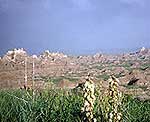By Cara Hetland
Minnesota Public Radio
June 6, 2002
New U.S. census figures released this week show South Dakota had the largest increase in the nation for household median income. The latest census information is for the 10-year period between 1990 and 2000. South Dakota still has the poorest county in the nation, even though it had a 57 percent growth in median income.
| |
|
|
|
||
The rise in median household income is attributed to several factors.
"Over the last 10 years, farm income in South Dakota has risen significantly - rising more quickly than the national average," according to Phil George, director of the South Dakota Labor and Market Center.
George says the annual pay for non-farm workers has also increased.
"I'm sure that's due to the fact that we've had a lot of good jobs come into South Dakota in the last 10 years - some high technology jobs, some health care jobs, some financial service jobs - which have been better-paying than the average, and helped raise the average in the state," he says.
George says during the boom years of the '90s, South Dakota consistently had a lower rate of unemployment than the national average. He says this forced businesses to pay higher salaries to attract quality workers.
About one-quarter of South Dakota's population lives in Sioux Falls. Census data shows there's a national trend where better-educated people live in urban centers. That's true for Sioux Falls.
Toby Madden is an economist with the Federal Reserve Bank in Minneapolis. He says in 1990, South Dakota had a low income base, and a 57 percent increase is significant. In 1990 the median household income was $22,500. In 2000, it jumped to nearly $35,300.
Madden says while the percentage increase is the largest in the nation, South Dakota's national income ranking is still 41st out of the 50 states.
|
"We've had a lot of good jobs come into South Dakota in the last 10 years - some high technology jobs, some health care jobs, some financial service jobs - which have been better-paying than the average."
- Phil George, South Dakota labor official |
"Things are improving. The work force is becoming more educated, your income is rising, the median household income is rising. From a trend perspective things are looking up," says Madden. "But then again, you shouldn't put too much into the numbers - saying we can rest on our laurels or we're the best - because there's room for improvement."
Madden says South Dakota's lack of a corporate and state income tax helps in attracting businesses to the state.
While the economy is good in South Dakota's population centers - the rural counties are suffering. Buffalo County in central South Dakota is now the poorest county in the nation. It's mostly reservation land owned by the Crow Creek Sioux Tribe.
Kally Kirkie, the tribe's grant writer, says economic development planning didn't start on her reservation until just a few years ago. There are only a handful of businesses in the county. The largest and most successful business is the Lode Star Casino.
"We have a couple other tribal enterprises - the tribal motel and tribal gas station and tribal liquor store. The other three are really struggling right now. We have one grocery store, and that store is packed especially this time of year," says Kirkie. "We could be a little tourist town if we did things right. There's never been no plans, no long term strategic planning or things like that."
Kirkie says it's her goal to build a tribal resort. She wants to encourage the thousands of anglers who fish the Missouri River to stay on tribal land. But she also wants to create jobs for her tribe's 3,500 members. She says part of the problem is tribal government changes every two years. She says change in leadership means change in priorities.
Most of the federal and casino money go toward welfare, health care and housing needs. Economic development falls to the bottom of the priority list without allocating any money. Kirkie says the national ranking could help them get some federal money.
In 1990, South Dakota's Shannon County made news when it was the poorest county in the nation. That ranking put the Pine Ridge Reservation in the federal government's Empowerment Zone. That gave the county millions in federal dollars for economic development. Even President Bill Clinton visited the reservation, putting it in the national spotlight.
Shannon County showed some income growth in the last ten years. But it still ranks as the nation's second poorest county.
More from MPR
